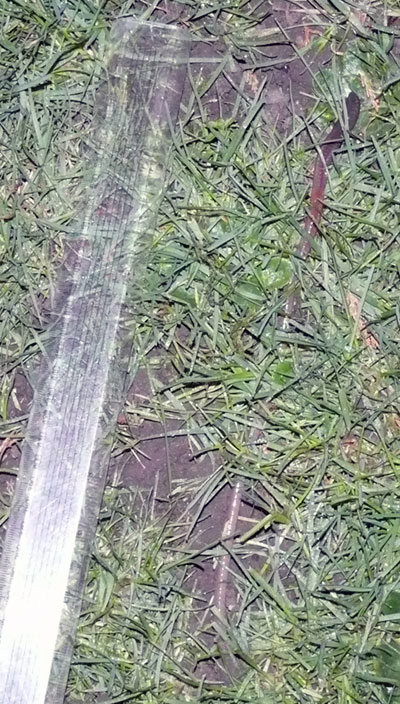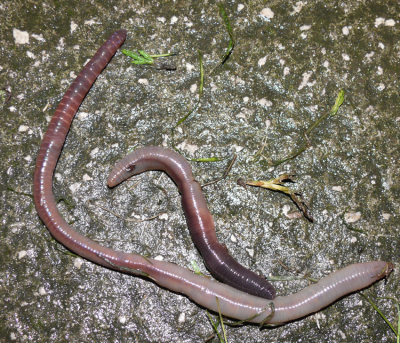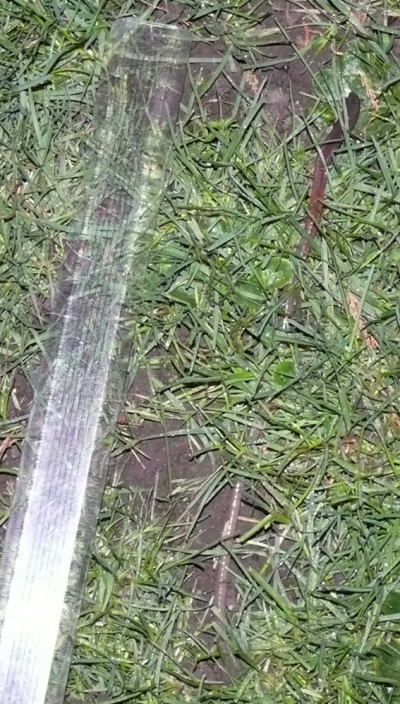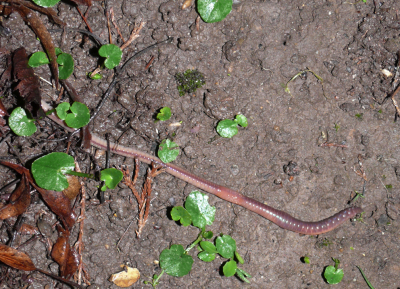As with most things concerning fishing, the prerequisite for success is more often than not dependant on the weather.
This is particulary so with collecting lob worms after dark. Most fishing books concern themselves with a few paragraphs about picking up worms from grass at night, but few go into any real detail as to what to expect under different conditions. If I start with the absolutely best conditions you could possibly hope for, then everything slowly tapers off for varied reasons thereafter.
Coincidentally, as I write, (7pm, 17 November) I would class tonight as the ultimate worming night. Although having said that, there’s been a few which have been positively frightening with the amount of worms at large. I mention the date and time, as it will all make sense as I go along. The one common factor with good worming conditions, is a wet night. This may take different forms; a mild dewy night, a night of light drizzle or a night of medium or torrential rain. If I’m in a really greedy mood, I’ve found that the more water the better.
 Take for instance this year. It’s been the hottest and driest for living memory or so we’ve been told, and quite rightly I haven’t seen a lob worm for months. Since this morning we’ve had almost constant drizzle interspersed with heavier bouts of warm rain. The ground is now saturated enough to bring the worms up, and as usual with lobs on a wet night, they can be found stretched out on the short grass. I previously mentioned the time and date for a purpose. The clocks have already gone back an hour and it now gets dark around 5pm or so. The wetter the ground is, the earlier the worms will start showing. If the ground had been, say, mildly damp, I wouldn’t have expected them to be up much before 7pm or so, and then only in small numbers. As the evening wears on, depending on other things, more and more will start to come up. Tonight for instance. As it has been raining now for a fair while and everywhere is very, very wet, lobs were up in some numbers at 5.30pm. I went and collected around 50 or so in about 15 minutes, which is pretty good going. I rested the general area and went back about 6.15pm and many more, and larger ones were up. Again, I collected the same amount of larger lobs in less time.
Take for instance this year. It’s been the hottest and driest for living memory or so we’ve been told, and quite rightly I haven’t seen a lob worm for months. Since this morning we’ve had almost constant drizzle interspersed with heavier bouts of warm rain. The ground is now saturated enough to bring the worms up, and as usual with lobs on a wet night, they can be found stretched out on the short grass. I previously mentioned the time and date for a purpose. The clocks have already gone back an hour and it now gets dark around 5pm or so. The wetter the ground is, the earlier the worms will start showing. If the ground had been, say, mildly damp, I wouldn’t have expected them to be up much before 7pm or so, and then only in small numbers. As the evening wears on, depending on other things, more and more will start to come up. Tonight for instance. As it has been raining now for a fair while and everywhere is very, very wet, lobs were up in some numbers at 5.30pm. I went and collected around 50 or so in about 15 minutes, which is pretty good going. I rested the general area and went back about 6.15pm and many more, and larger ones were up. Again, I collected the same amount of larger lobs in less time.
Tonight is a calm, muggy mild night. Under these conditions the worms will be out probably all night until dawn, and at such times it is best to stock up a wormery if you’ve got one going. These are the kind of nights to go out, say, several times with rests in between, and really stock up with hundreds of big lobs. On these nights, a walk along any street lit tarmac path will show lobs fully stretched out across the actual path, from holes in the edges of grass verges, lawns, bases of cracked walls etc.
Living on a housing estate as I do, there are many areas of grass. Play areas, roundabouts and grass verges being the most prolific. Depending on many different things, you’ll notice easier and harder nights with your worm collecting. The wetter the ground is, provided the evening is mild and muggy, the earlier the worms will be up; usually shortly after dark. They will increase in numbers as the evening progresses. On the best of nights, after an hour or so they will be fully stretched out, feeding and mating.
Should the temperature drop appreciably or a wind get up(especially a cold one), or both, it’ll mean the worms going back down their holes. Cold weather and wind does not impress them at all. If you notice the temperature or wind changing for the worse, you’ll have to time your collecting accordingly before they retreat back down their holes. The following night could be just as wet, but if the temperatures really dropped, only the odd worm would be showing.
The actual amount of time a worm is out of its hole is dependant on how wet and mild it is. Tonight they’re out in their thousands, and it’ll be the same more or less everywhere. That said, some areas are continually good worm areas and some not so good or totally useless. Only by trial and error will you eventually begin to know which areas are good under what particular conditions.
The best spots I’ve found are ones which you would not generally think would be, but there is a reason. Most books tell you of football fields and close cut lawns as being the places to look. Close cut lawns and pitches are good enough, as looking for and pulling lobs from long grass is a nightmare. In long grass you only get a partial view of the worm, plus it’s easy to scare it back down the hole if you knock a grass blade trying to get it. Sometimes in very windy weather, long grass is one of the only places you’ll find a few, as obviously there’s more shelter under matted grass. Windy nights are not good worm nights as a rule anyway.
 I’ve found the best areas by far, are the grass verges right alongside secondary or main roads, especially around street lighting. Some books advocate roundabouts as good spots for this same reason. At first I used to shun such areas, thinking no self-respecting worm would put up with the amount of light, passing cars, noise and disturbance. All my worming was therefore carried out on our back lawn or play areas away from such disturbances. Of course I found worms in all these areas, but you only had to swing a small torch near a worm and the thing would zip back down the hole like a shot. At best you’ve got maybe a second or two to sight the worm, check which end is going down the hole, position yourself, bend down and make your move. By which time in these darkened areas, the thing is nowhere to be seen. On good nights in these areas you could end up with maybe 20 lobs for over an hour’s effort. Certainly enough for a good fish, but too much effort for too little reward. The lobs on the street lit grass verges are hardened to the amount of light and constant noise and disturbance, hence you can go right up to these guys and shine a bright torch right on them and they take no notice whatsoever. On good torrential type nights, the verges are criss-crossed with hundreds of worms, and you can carefully pick them out one by one, not even disturbing others mere inches away. Tonight, I collected 20 or so huge lobs from one spot without moving more than ten feet.
I’ve found the best areas by far, are the grass verges right alongside secondary or main roads, especially around street lighting. Some books advocate roundabouts as good spots for this same reason. At first I used to shun such areas, thinking no self-respecting worm would put up with the amount of light, passing cars, noise and disturbance. All my worming was therefore carried out on our back lawn or play areas away from such disturbances. Of course I found worms in all these areas, but you only had to swing a small torch near a worm and the thing would zip back down the hole like a shot. At best you’ve got maybe a second or two to sight the worm, check which end is going down the hole, position yourself, bend down and make your move. By which time in these darkened areas, the thing is nowhere to be seen. On good nights in these areas you could end up with maybe 20 lobs for over an hour’s effort. Certainly enough for a good fish, but too much effort for too little reward. The lobs on the street lit grass verges are hardened to the amount of light and constant noise and disturbance, hence you can go right up to these guys and shine a bright torch right on them and they take no notice whatsoever. On good torrential type nights, the verges are criss-crossed with hundreds of worms, and you can carefully pick them out one by one, not even disturbing others mere inches away. Tonight, I collected 20 or so huge lobs from one spot without moving more than ten feet.
Also, the worms in these areas tend to be giants. I’ve a theory that as these verges are being continually ‘used’ by dogs, these areas are richer in nutrients than others further afield. To collect worms, I wear thin cotton gardening gloves which give some amount of grip. Too thick though and you can’t feel what you’re doing and broken worms will result. Should the wind get up, then the worms in the more exposed areas will start to retreat. It’s then that you have to move to search areas out of the wind, behind walls and fences etc, where the worms will still be up. After several trips in different types of weather, you’ll soon begin to notice a pattern developing, and you’ll have to go about your collecting with this in mind.
 As for the actual taking of worms, most books just say to go for the end which is going down the hole (the lighter coloured end, as the head is always darker), lightly trap the worm and pick it up. True enough. Some nights, the real deluge wash-out nights, you can just pick them up, even from the paths where they’re off somewhere else. Trouble is, most nights you’ll be faced with only an inch of the head showing. Depending on the weather, what kind of night it is and what I’ve said before, it makes a difference what you do next. If it’s a good night and you know that they’ll still be out later, it might be best to go in and come back out in a while when they’ll be further out of their holes. If you’re stuck for time or the temperatures are on the drop, it may mean they WON’T be coming out any further, and you’ll have to try and get what you can when you can.
As for the actual taking of worms, most books just say to go for the end which is going down the hole (the lighter coloured end, as the head is always darker), lightly trap the worm and pick it up. True enough. Some nights, the real deluge wash-out nights, you can just pick them up, even from the paths where they’re off somewhere else. Trouble is, most nights you’ll be faced with only an inch of the head showing. Depending on the weather, what kind of night it is and what I’ve said before, it makes a difference what you do next. If it’s a good night and you know that they’ll still be out later, it might be best to go in and come back out in a while when they’ll be further out of their holes. If you’re stuck for time or the temperatures are on the drop, it may mean they WON’T be coming out any further, and you’ll have to try and get what you can when you can.
This means you’ll be trying to pull out lobs with only the tips of their heads, or at best, maybe an inch showing. You’ll be faced with this situation on drier evenings, windy evenings and cooler evenings, all of which will mean the worms won’t be fully out. Wearing gloves, I find it best to gently trap the worm by pressing your forefinger where it disappears down the hole. It then can’t move. With the other hand, using perhaps forefinger and thumb as gently as you can, pull up the worm using both sets of fingers etc and gently ease it out. It will pull back like crazy but within a few seconds it will give up and you can feel the whole worm slowly lifting out. Be very gentle on all counts, as what you don’t want to do is break the worm in half – which happens – or get it out but with a severely squeezed head. Bit difficult to explain, but I try and “grip” the worm along the length of my fingers rather than pinch it at one point. I try to do this as far back from the head as I can. As the worm slowly comes out, I work my fingers along the body away from the head, moving it along. Holding the worm like this, the pressure of your fingers is along, say, two inches of its body, and is less damaging than if you pinched it in one spot and pulled like crazy. You’ll damage everyone you pull like that.
Depending on the worm and how wet the ground is, some will respond to a slow and constant pull, but most respond better to several really gentle pulls, slackening off momentarily in between. For some reason, I find it works quite well. The ones which break I discard immediately. The ones which appear squeezed I let go. If the fishing trip is the next day, and you haven’t got too many worms, then it’s okay to take everything, as even the damaged or cut ones will do for the next day. What you absolutely DON’T do is keep cut or damaged ones any length of time as they’ll make the rest of the good ones go off, and ruin your whole supply within a couple of days. If you’re on for a good night, just go for the ones you need in particular, and discard any which may appear a bit too distressed at having being caught.
You’ll find the wetter the ground, the easier it is to pull the worms from their holes. If you’re lucky enough to find any worms on a dry night on hard ground, you’ll probably break and damage more than you’ll get good ones. Mind you, you’ll be out ages looking for a handfull anyway under these conditions. On these nights, look around the bases of fences or under fallen leaves where it may be slightly damper. Forget exposed areas on dry nights; it’s really not worth the effort. Sometimes if you deperately need worms and the conditions are completely hopeless, then letting a hose run on the area in question, may get you a few which otherwise you wouldn’t have done.
 I like to collect mine fresh, the evening before a trip, but in times of protracted hot weather, I’ve often resorted to a wormery. I’ve done nothing more elaborate than get a big plastic tub (although I’ve read a wooden one is best) and fill it with a mixture of loose garden compost or leaf mould and moss. I’ve kept this in a cool dark area like the garage, with some netting over the top. Every now and then I loosen up the soil and discard any worms which don’t look too good. I’ve read that you can freeze some plastic bottles full of water and place these inside the container in times of hot weather. This helps prevent them overheating. It seems to have worked okay. I’ve tried the old shredded newspaper ploy, and they seem happy enough in that, but I’ve always gone back to some nice loose leafmould and moss. It’s then a simple matter of getting a few out whenever you need them, however I never put back ones I’ve taken out just in case they’ve been damaged while I’ve been fishing. I usually just let these go.
I like to collect mine fresh, the evening before a trip, but in times of protracted hot weather, I’ve often resorted to a wormery. I’ve done nothing more elaborate than get a big plastic tub (although I’ve read a wooden one is best) and fill it with a mixture of loose garden compost or leaf mould and moss. I’ve kept this in a cool dark area like the garage, with some netting over the top. Every now and then I loosen up the soil and discard any worms which don’t look too good. I’ve read that you can freeze some plastic bottles full of water and place these inside the container in times of hot weather. This helps prevent them overheating. It seems to have worked okay. I’ve tried the old shredded newspaper ploy, and they seem happy enough in that, but I’ve always gone back to some nice loose leafmould and moss. It’s then a simple matter of getting a few out whenever you need them, however I never put back ones I’ve taken out just in case they’ve been damaged while I’ve been fishing. I usually just let these go.
Hopefully there may be a few things amongst that lot which help the bidding worm hunter, especially if he’s starting out from scratch. As a general rule, the wetter, calmer, more muggy drizzly nights, the better it is. Good luck.
Maurice Pledger.










